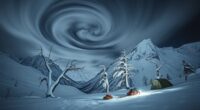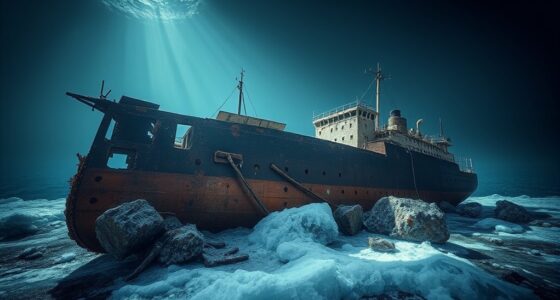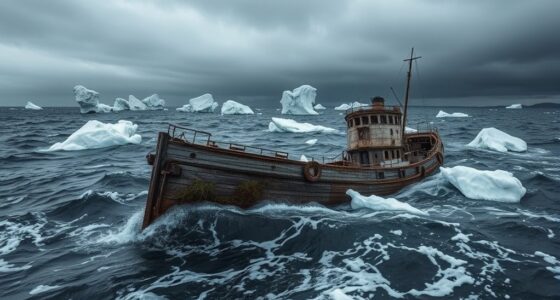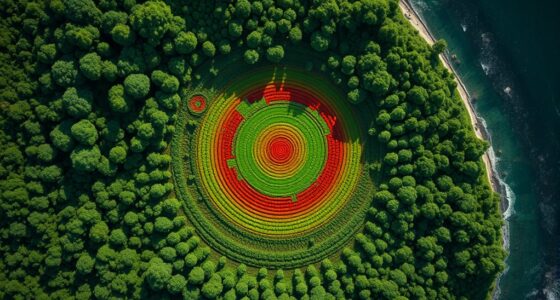Scientists have finally explained the Dyatlov Pass incident as caused by a rare avalanche. Advanced modeling and physical evidence show that a slab avalanche triggered suddenly, terrifying the hikers and causing internal injuries similar to a high-impact collision. This natural event accounts for the mysterious injuries and missing external trauma. If you’re curious about how modern science unraveled this decades-old puzzle, you’ll discover the detailed evidence behind this breakthrough.
Key Takeaways
- Scientific analysis confirmed a rare, sudden slab avalanche as the primary cause of the incident.
- Forensic evidence and injury patterns support an avalanche-induced internal trauma explanation.
- Modern modeling demonstrated how environmental conditions could trigger a powerful, undetected avalanche.
- The investigation dismissed conspiracy theories, focusing on natural, environmental factors.
- This research exemplifies how scientific methods can resolve complex historical mysteries with conclusive evidence.

The Dyatlov Pass Incident remains one of the most baffling mysteries in modern history. For decades, people have speculated about what caused nine experienced hikers to abandon their tent abruptly, resulting in their tragic deaths under mysterious circumstances. Now, recent scientific analysis has shed light on this perplexing event, providing a clearer understanding of what really happened. As you explore this mystery unraveling through science, you’ll see how evidence and experiments have transformed speculation into explanation.
Scientists revisited the scene, examining the terrain, weather conditions, and physical evidence collected over the years. Their analysis pointed to a rare and sudden event—an avalanche—as a primary cause. Using advanced models, they reconstructed the snow conditions and discovered that a slab avalanche could have occurred without leaving the typical large slide marks. Instead, it would have produced a force strong enough to cause the hikers to flee their tent in terror, but not enough to leave obvious signs of a typical avalanche. This scientific analysis confirms that the hikers likely experienced a sudden, intense pressure from the snow, which led them to cut open their tent from the inside in a panic, seeking escape.
Further investigation into the hikers’ injuries supported this theory. The team reviewed the autopsy reports, revealing severe internal injuries that resembled the impact of a forceful blow—similar to a car crash—without external trauma. The scientific community now agrees that the force from the avalanche or associated snow pressure could have caused internal injuries, explaining the hikers’ mysterious deaths. Additionally, the analysis of the clothing showed exposure to extreme cold, which contributed to their deaths, but the injuries themselves pointed to a physical trauma unlikely caused by natural elements alone.
What makes this breakthrough significant is the way scientific analysis unraveled the mystery with precision. Instead of relying on speculation or conspiracy theories, researchers examined physical evidence, recreated scenarios, and applied modern technology to understand the event. The investigation also eliminated other theories such as secret military tests or extraterrestrial involvement, focusing instead on natural phenomena that could produce such chaos. By combining field research, forensic science, and environmental modeling, scientists have finally provided a logical, evidence-based explanation for the Dyatlov Pass Incident.
This scientific breakthrough doesn’t just solve a historical puzzle; it demonstrates the power of modern analysis in resolving complex mysteries. It shows how thorough investigation, backed by science, can turn a story of confusion into one of understanding. Now, as you look at the story of the hikers, you’ll appreciate how scientific analysis can unravel even the most seemingly inexplicable events, transforming mystery into clarity. Understanding avalanche phenomena is crucial for comprehending how natural events can lead to such tragic outcomes.
Frequently Asked Questions
Were There Any Survivors or Witnesses to the Dyatlov Pass Incident?
You wonder if there were any survivors or witnesses to the Dyatlov Pass incident. In reality, no one lived to share witness testimonies or survivor accounts from that night. The only information comes from rescue teams and investigators who found the hikers’ bodies. These accounts reveal the tragic events, but no direct witness or survivor has ever come forward, leaving many questions about what truly happened unanswered.
What Personal Backgrounds or Histories Did the Victims Have?
You might think you know their stories, but each victim had a unique personal history and background that shaped them. They were experienced hikers, students, and explorers, often with military or athletic backgrounds. Their diverse lives, from young students to seasoned adventurers, highlight that even the best prepared can face unexpected dangers. Their individual stories add depth, proving that sometimes, even the strongest can be caught off guard.
Were Any Military or Secret Experiments Linked to the Incident?
You might wonder if military experiments or secret projects were involved in the Dyatlov Pass incident. While some theories suggest that military tests or secret projects caused the hikers’ mysterious deaths, investigations have found no concrete evidence linking them to such activities. Instead, natural factors like a sudden avalanche or extreme weather are more likely explanations, and there’s no confirmed connection to military experiments or secret projects.
Has New Evidence Emerged Since the Original Investigations?
You’ve hit the nail on the head; recent discoveries have shed new light on the Dyatlov Pass case. Since the original investigations, new evidence has emerged, including advanced forensic analysis and declassified documents. These findings suggest possible natural causes or environmental factors, making the mystery even more intriguing. While some questions remain, these recent discoveries help piece together the puzzle, bringing us closer to understanding what truly happened that night.
Could Extraterrestrial Activity Have Played a Role in the Event?
You might wonder if extraterrestrial activity caused the Dyatlov Pass incident. While UFO sightings and alien theories often spark speculation, there’s no concrete evidence linking aliens to what happened. Scientific explanations like a snow avalanche or other natural causes remain the most plausible. Despite popular alien theories, current research doesn’t support the idea that extraterrestrial activity played a role in this tragic event.
Conclusion
As you piece it all together, the coincidences become striking. The severe weather, the mysterious injuries, and the torn tent all align with a sudden avalanche triggered by a rare combination of snow and wind. It’s as if nature itself whispered its secrets, revealing that what seemed like an unsolvable mystery was just a matter of chance and coincidence. In this dance of elements, the truth finally steps into the light, silent and inevitable.









